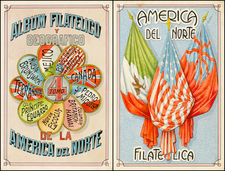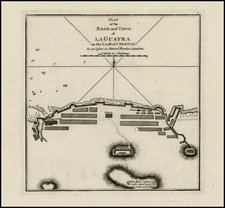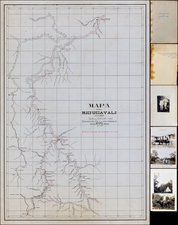A Fantastic Spanish Map and Narrative Broadside Announcing the English Defeat at Cartagena de Indias in 1741.
Separately issued engraved and letterpress broadside issued on the event of the Spanish victory over Admiral Vernon and the English in 1741.
This is one of very few Spanish maps to record the events of the Battle of Cartagena. We have not handled another one. English map publishers were far more prolific than their Spanish counterparts in their coverage of the events surrounding Vernon's defeat.
Pablo Minguet
Pablo Minguet (fl. 1733-1775) was a Spanish polymath, who is known today as a writer, artist, engraver, and composer. Early in his career he was also a map engraver. His maps are very scarce; we have only ever handled one other map by him, a+1730s+map+of+the+world.
The Battle of Cartagena
The Battle of Cartagena de Indias was an amphibious military engagement between the forces of Britain under Vice-Admiral Edward Vernon and those of Spain under Admiral Blas de Lezo. It took place at the city of Cartagena de Indias, in March 1741, in present-day Colombia. The battle was a significant episode of the War of Jenkins' Ear and a large-scale naval campaign.
Cartagena, in the 18th century, was a large and rich city of over 10,000 people. It was the capital of the province of Cartagena and the main town had significant fortifications that had been recently repaired, increased and improved with outlying forts, batteries and works. Its harbor was considered one of the finest in the world and it served the galleons of the commercial fleet, Galeones a Tierra Firme y Perú, that annually conveyed through Havana to Spain the immense revenues of gold and silver from New Granada and Peru.
Founded by Pedro Heredia in 1533, it had been the target of conquest in the past and was captured by the English, under Francis Drake, in 1585 and by the French, under Baron de Pointis in 1697. The city faces the Caribbean to the west, to the south its bay has two entrances: Boca Chica (Little Mouth) and Boca Grande (Big Mouth). Boca Chica was the only deep water entrance and was so narrow it allowed the passage of only one ship at a time. This entrance was defended on one side by the Fort San Luis with a couple of small outworks on the peninsula of Terra Bomba and on the other side by the fascine battery Baradera.
Beyond Boca Chica was the great lagoon of the outer harbor with an entry channel into the inner harbor between two peninsulas, each defended by a fort. The walls of the city itself mounted some 160 cannon and the suburbs 140 guns. The city was surrounded by a water-filled ditch and its gates supported by recently built bastions. The suburbs were also surrounded by a wall and ditch. About a quarter mile south from the city on a hill was Fort San Lazaro, a square fifty feet on a side with three demi-bastions. The position of Fort San Lazaro commanded the city itself and the plane around the hill. There was also a small hill nearby that commanded Fort Lazaro, but there was no fresh water source available outside Cartagena and the fort. The road from the best landing point, the beach at Texar de Gracias, to Fort Lazaro, was three miles long.
The British invasion force consisted of:
- 186 ships including: 29 Ships of the Line; 22 frigates, 2 hospital ships, various fire ships and bomb ships armed with a total of some 2,000 cannon; 80 troop transports and 50 merchant ships.
- 27,400 military personnel, of which the land force totaled 12,000 including: two British regular infantry regiments, the 15th Foot and 24th Foot, 6,000 newly raised marines
- 3,600 American colonial troops, commanded by Colonel William Gooch (the Lieutenant Governor of Virginia), in four battalions designated as the 43rd Regiment of Foot, arriving from the North American colonies on another 40 transports.
The Spanish force defending Cartagena included:
- 2,700 to 3,000 Spanish regulars from the regiments Aragon, España and that of Toledo, Lisboa and Navarra who had arrived in October 1740, brought by Vice-admiral Torres; a colonial regiment from Cartagena; an unspecified number of sailors;
- 5 companies of militia and 600 Indian archers,
- 4,000 to 6,000 defenders, manning six Ships of the Line and strategic fortifications - under the command of the Governor General of Cartagena, Don Blas de Lezo and the Viceroy of New Granada, Sebastián de Eslava.
The expedition and battle lasted for days and ended with the British fleet withdrawing in defeat, with 18,000 dead or incapacitated, mostly by disease. The Spanish also suffered severely from disease including Blas de Lezo himself, who died a few weeks after falling ill from the plague from unburied bodies. In addition, a total of 50 British ships were lost, badly damaged, disabled or abandoned for lack of crews. There were nineteen ships of the line damaged, four frigates and twenty-seven transports lost.
Of the 3,600 American colonists who had volunteered, lured by promises of land and mountains of gold, most died of yellow fever, dysentery, and outright starvation. Only 300 returned home, including Lawrence Washington, who renamed his Virginia plantation, Mount Vernon after Admiral Vernon.
Rarity
Extremely rare; this is the only known example of this state. An example of another edition of the broadside, with modified text, is pasted into a composite album in the library of the Universidad Complutense de Madrid.









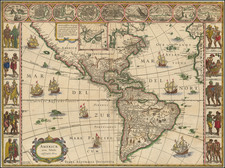
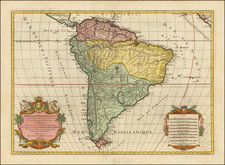
![Suite Du Bresil . . . [2 maps]](https://storage.googleapis.com/raremaps/img/small/103662.jpg)
